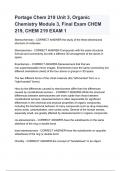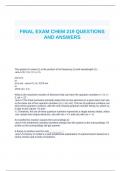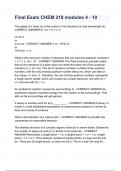Chem 219 final exam - Study guides, Class notes & Summaries
Looking for the best study guides, study notes and summaries about Chem 219 final exam? On this page you'll find 50 study documents about Chem 219 final exam.
Page 4 out of 50 results
Sort by
Portage Chem 219 Unit 3, Organic Chemistry Module 3, Final Exam CHEM 219, CHEM 219
FINAL EXAM CHEM 219 QUESTIONS AND ANSWERS
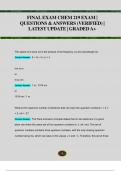
-
FINAL EXAM CHEM 219 EXAM | QUESTIONS & ANSWERS (VERIFIED) | LATEST UPDATE | GRADED A+
- Exam (elaborations) • 22 pages • 2024
-
- $11.49
- + learn more
1 FINAL EXAM CHEM 219 EXAM | QUESTIONS & ANSWERS (VERIFIED) | LATEST UPDATE | GRADED A+ The speed of a wave (c) is the product of its frequency (ν) and wavelength (λ). Correct Answer: E = hv = h x c / λ nm to m or m to nm Correct Answer: 1 m / 10^9 nm or 10^9 nm / 1 m What is the maximum number of electrons that can have the quantum numbers n = 3, ℓ = 2, mℓ = -2? Correct Answer: The Pauli exclusion principle states that no two electrons in a given atom can share the sa...

-
Organic Chemistry Module 8 Portage 219 TEST EXAM FINALS QUESTIONS WITH 100% VERIFIED SOLUTIONS
- Exam (elaborations) • 15 pages • 2024
-
- $12.99
- + learn more
Organic Chemistry Module 8 Portage 219 TEST EXAM FINALS QUESTIONS WITH 100% VERIFIED SOLUTIONS Polymer - ANSWER large molecule made by repetitive linking of smaller units (monomers) Macromolecule - ANSWER very large molecule composed of thousands of covalently bonded atoms (ex: polymer) 1. natural (in nature) 2. synthetic (in lab) - ANSWER two ways polymers are made rubber, carbs: starch & cellulose, proteins, nucleic acids DNA, RNA - ANSWER natural polymers nylon, teflon, sty...
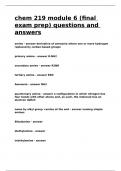
-
chem 219 module 6 (final exam prep) questions and answers
- Exam (elaborations) • 13 pages • 2024
-
- $13.99
- + learn more
amine derivative of ammonia where one or more hydrogen replaced by carbon-based groups primary amine R-NH2 Previous Play Next Rewind 10 seconds Move forward 10 seconds Unmute 0:00 / 0:15 Full screen Brainpower Read More secondary amine R2NH tertiary amine R3N Ammonia NH3 quarternary amine a configuration in which nitrogen has four bonds with other atoms and, as such, the molecule has an electron deficit name by alkyl group +amine at t...
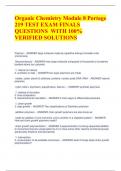
-
Organic Chemistry Module 8 Portage 219 TEST EXAM FINALS QUESTIONS WITH 100% VERIFIED SOLUTIONS
- Exam (elaborations) • 15 pages • 2024
-
- $14.49
- + learn more
Organic Chemistry Module 8 Portage 219 TEST EXAM FINALS QUESTIONS WITH 100% VERIFIED SOLUTIONS Polymer - ANSWER large molecule made by repetitive linking of smaller units (monomers) Macromolecule - ANSWER very large molecule composed of thousands of covalently bonded atoms (ex: polymer) 1. natural (in nature) 2. synthetic (in lab) - ANSWER two ways polymers are made rubber, carbs: starch & cellulose, proteins, nucleic acids DNA, RNA - ANSWER natural polymers nylon, teflon, sty...
Final Exam CHEM 219 modules 4 - 10
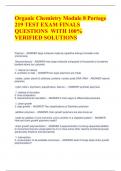
-
Organic Chemistry Module 8 Portage 219 TEST EXAM FINALS QUESTIONS WITH 100% VERIFIED SOLUTIONS
- Exam (elaborations) • 15 pages • 2024
-
- $12.49
- + learn more
Organic Chemistry Module 8 Portage 219 TEST EXAM FINALS QUESTIONS WITH 100% VERIFIED SOLUTIONS Polymer - ANSWER large molecule made by repetitive linking of smaller units (monomers) Macromolecule - ANSWER very large molecule composed of thousands of covalently bonded atoms (ex: polymer) 1. natural (in nature) 2. synthetic (in lab) - ANSWER two ways polymers are made rubber, carbs: starch & cellulose, proteins, nucleic acids DNA, RNA - ANSWER natural polymers nylon, teflon, sty...
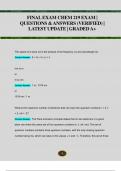
-
FINAL EXAM CHEM 219 EXAM | QUESTIONS & ANSWERS (VERIFIED) | LATEST UPDATE | GRADED A+
- Exam (elaborations) • 22 pages • 2024
-
- $11.49
- + learn more
The speed of a wave (c) is the product of its frequency (ν) and wavelength (λ). Correct Answer: E = hv = h x c / λ nm to m or m to nm Correct Answer: 1 m / 10^9 nm or 10^9 nm / 1 m What is the maximum number of electrons that can have the quantum numbers n = 3, ℓ = 2, mℓ = -2? Correct Answer: The Pauli exclusion principle states that no two electrons in a given atom can share the same set of four quantum numbers (n, ℓ, mℓ, ms). This set of quantum numbers contains three...

-
Final Exam CHEM 219 Questions and Answers | Latest Update
- Exam (elaborations) • 26 pages • 2024
-
- $12.49
- + learn more
The speed of a wave (c) is the product of its frequency (ν) and wavelength (λ). E = hv = h x c / λ nm to m or m to nm 1 m / 10^9 nm or 10^9 nm / 1 m What is the maximum number of electrons that can have the quantum numbers n = 3, ℓ = 2, mℓ = -2? The Pauli exclusion principle states that no two electrons in a given atom can share the same set of four quantum numbers (n, ℓ, mℓ, ms). This set of quantum numbers contains three quantum numbers, with the only missing qua...

Do you wonder why so many students wear nice clothes, have money to spare and enjoy tons of free time? Well, they sell on Stuvia! Imagine your study notes being downloaded a dozen times for $15 each. Every. Single. Day. Discover all about earning on Stuvia

